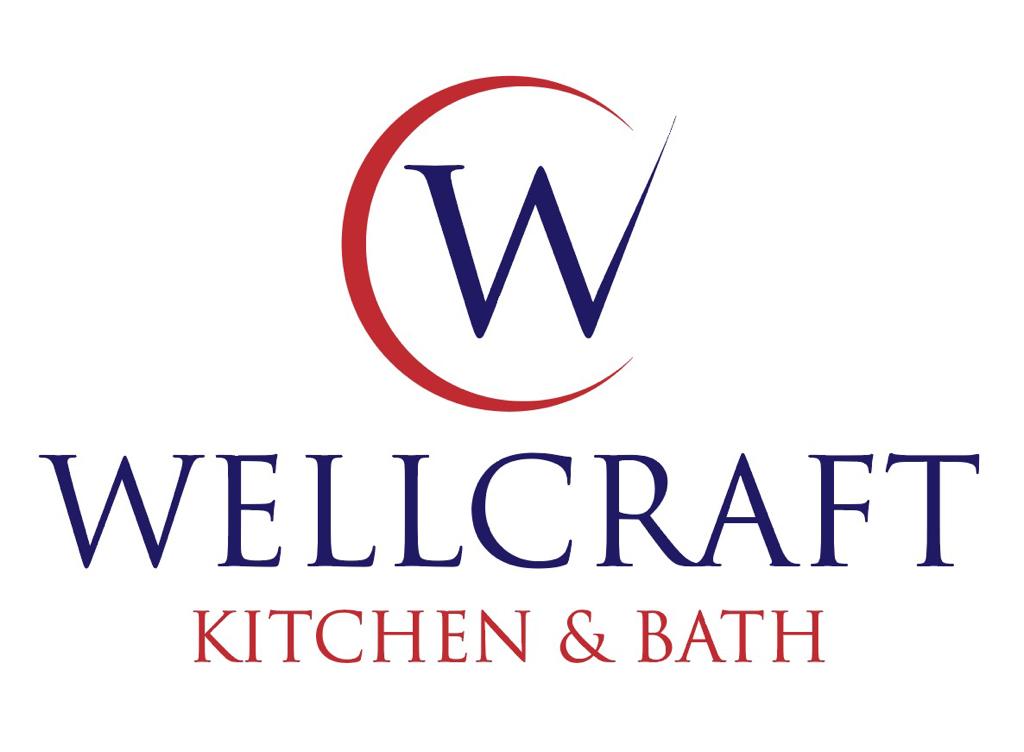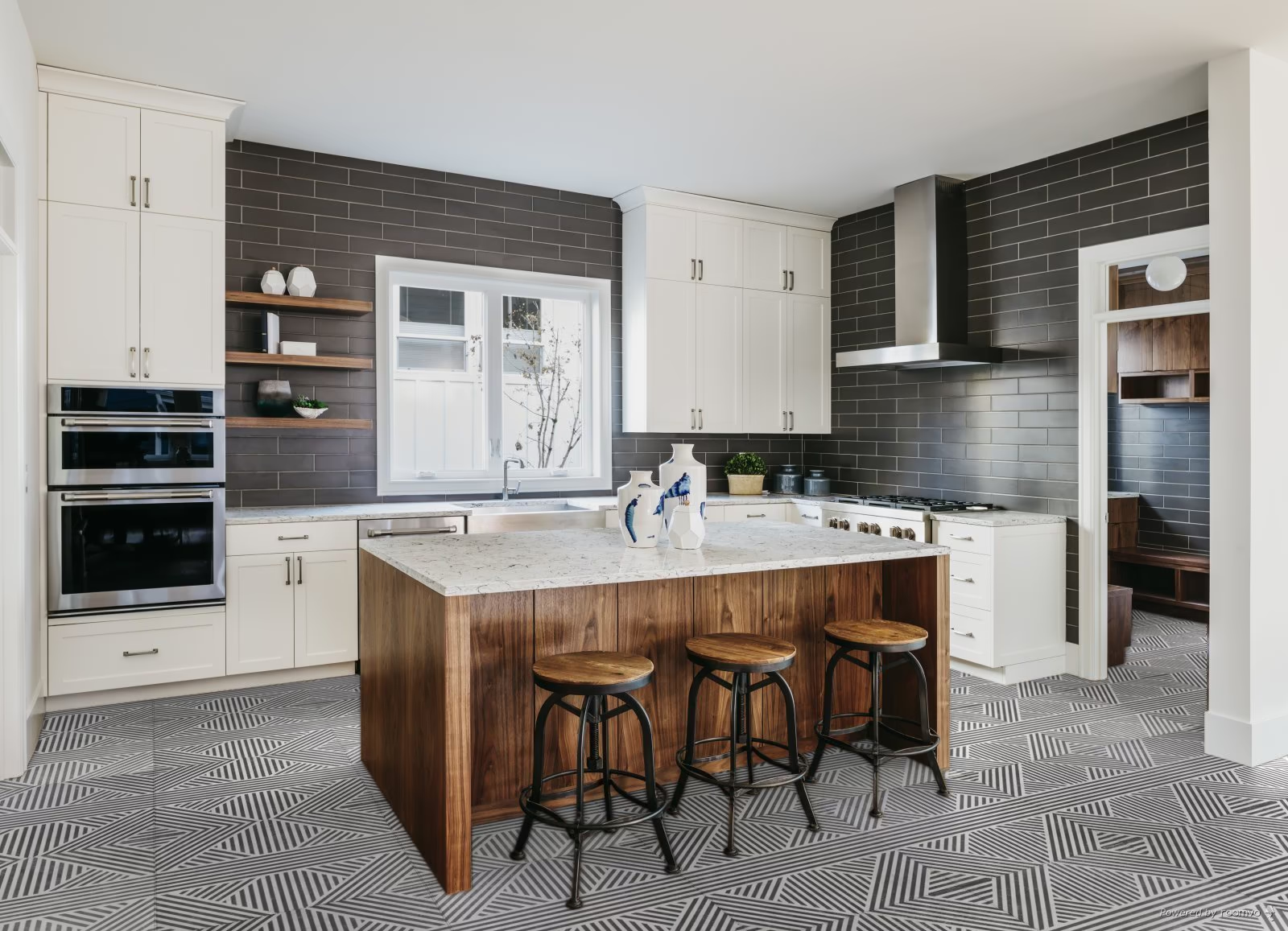Contents
- 1 Introduction
- 2 1. Types of Kitchen and Floor Tiles: Material Options and Characteristics
- 3 2. Porcelain Kitchen and Floor Tiles: Premium Performance and Design
- 4 3. Natural Stone Kitchen and Floor Tiles: Authentic Beauty and Character
- 5 4. Ceramic Kitchen and Floor Tiles: Versatile and Affordable Options
- 6 5. Large Format Kitchen and Floor Tiles: Modern Aesthetics and Practical Benefits
- 7 6. Kitchen and Floor Tiles Installation: Professional Techniques and Best Practices
- 8 7. Maintenance and Care for Kitchen and Floor Tiles
- 9 8. Design Trends and Styling with Kitchen and Floor Tiles
- 10 Conclusion
- 10.1 What are the most durable kitchen and floor tiles for high-traffic areas?
- 10.2 How do I choose the right size kitchen and floor tiles for my space?
- 10.3 What's the difference between ceramic and porcelain kitchen and floor tiles?
- 10.4 How much should I budget for kitchen and floor tiles installation?
- 10.5 What maintenance do kitchen and floor tiles require to maintain their appearance?
- 11 Sources/References
Introduction
Selecting the perfect kitchen and floor tiles requires understanding the complex interplay between aesthetic preferences, functional requirements, and long-term performance characteristics that define successful tile installations in modern homes. Kitchen and floor tiles serve as foundational design elements that influence both immediate visual impact and daily functionality while providing decades of service when properly selected and installed.
The world of kitchen and floor tiles has evolved dramatically with technological advances in manufacturing, design innovation, and performance enhancement creating options that were previously impossible or prohibitively expensive. Modern kitchen and floor tiles can replicate natural materials with stunning accuracy while providing superior performance characteristics including stain resistance, durability, and easy maintenance essential for contemporary living.
Understanding the various types of kitchen and floor tiles available enables homeowners to make informed decisions that align with their design vision, budget constraints, and lifestyle requirements. From traditional ceramic options to cutting-edge porcelain innovations, the range of kitchen and floor tiles continues to expand with new materials, sizes, and design possibilities emerging regularly.
Professional selection of kitchen and floor tiles involves careful consideration of factors including room size, lighting conditions, traffic patterns, moisture exposure, and maintenance preferences that influence both immediate satisfaction and long-term performance. The best kitchen and floor tiles balance aesthetic appeal with practical functionality while providing excellent value for the investment.
Installation quality significantly impacts the performance and longevity of kitchen and floor tiles, with proper subfloor preparation, appropriate adhesives, and professional techniques ensuring optimal results that maximize the investment in quality materials. Understanding installation requirements helps homeowners make informed decisions about DIY versus professional installation.
This comprehensive guide explores every aspect of kitchen and floor tiles, from material types and design options to installation techniques and maintenance requirements, providing the knowledge necessary to select and install tiles that enhance both beauty and functionality in modern homes.
1. Types of Kitchen and Floor Tiles: Material Options and Characteristics
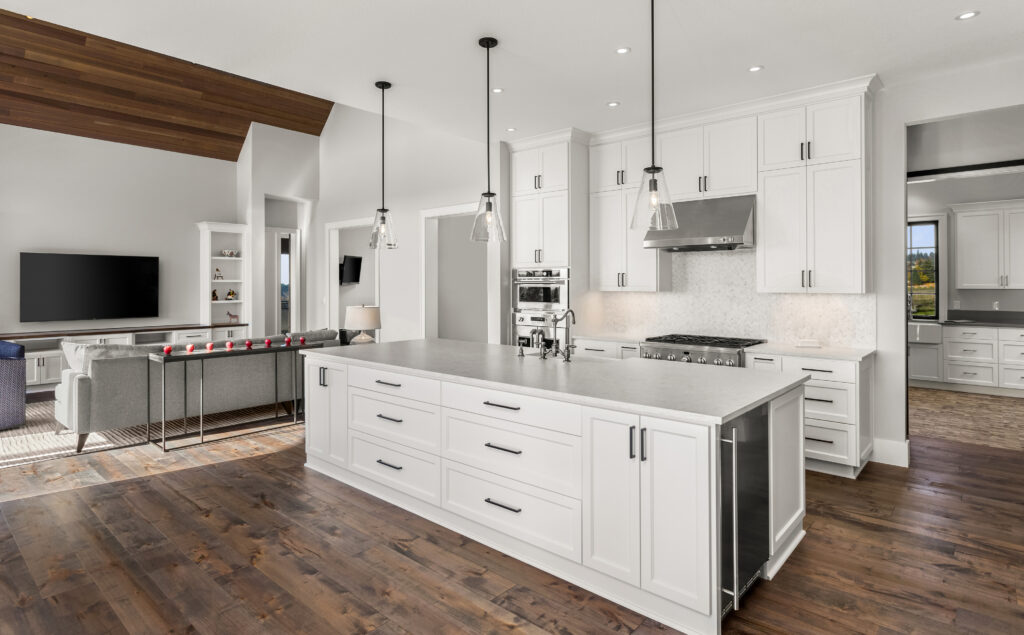
Understanding the various types of kitchen and floor tiles available helps homeowners select materials that best meet their specific needs for durability, aesthetics, and performance while staying within budget constraints and maintenance preferences that support long-term satisfaction with tile installations.
Primary Kitchen and Floor Tiles Categories:
- Ceramic tiles offering affordability and versatile design options
- Porcelain tiles providing superior durability and water resistance
- Natural stone tiles delivering authentic beauty and unique character
- Glass tiles creating luminous effects and easy maintenance
- Metal tiles adding contemporary sophistication and durability
- Composite tiles combining materials for enhanced performance
- Specialty tiles including textured and three-dimensional options
- Large format tiles creating seamless, modern appearances
Ceramic tiles represent the most traditional and widely used kitchen and floor tiles, manufactured from clay and other natural materials fired at high temperatures to create durable, versatile surfaces suitable for most residential applications. Modern ceramic tiles offer excellent value with improved durability and design options that make them suitable for both walls and floors in kitchen environments.
Porcelain tiles have become increasingly popular kitchen and floor tiles due to their superior density, water resistance, and durability characteristics that exceed traditional ceramic options. The manufacturing process creates tiles with extremely low water absorption rates and exceptional strength that make porcelain suitable for high-traffic areas and demanding applications.
Natural stone tiles including marble, granite, travertine, and slate provide authentic beauty and unique character that make each installation distinctive. These kitchen and floor tiles offer unmatched natural beauty but require more maintenance and care than manufactured alternatives while providing excellent long-term value and prestige.
Glass tiles create stunning visual effects in kitchen and floor tiles applications through their reflective properties and ability to enhance lighting while providing excellent stain resistance and easy maintenance. Modern glass tiles are available in numerous colors, sizes, and finishes that enable creative design applications.
The development of large format tiles has revolutionized kitchen and floor tiles installations by creating seamless appearances with minimal grout lines while reducing installation time and maintenance requirements. These tiles, often measuring 24×48 inches or larger, create contemporary aesthetics while providing practical benefits.
2. Porcelain Kitchen and Floor Tiles: Premium Performance and Design
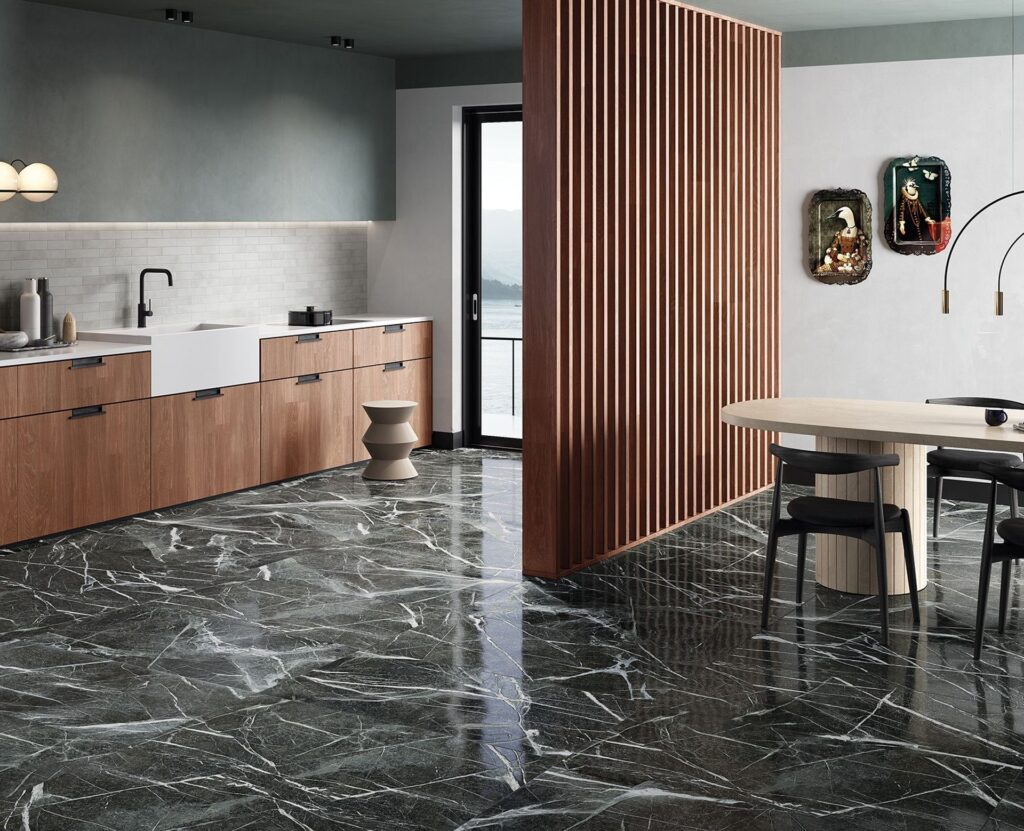
Porcelain kitchen and floor tiles represent the pinnacle of manufactured tile technology, offering exceptional durability, water resistance, and design versatility that make them ideal for demanding kitchen applications while providing aesthetic options that rival natural materials.
Advanced Porcelain Kitchen and Floor Tiles Features:
- Ultra-low water absorption rates preventing moisture damage
- Superior strength and impact resistance withstanding heavy use
- Through-body construction ensuring consistent appearance
- Digital printing technology creating photorealistic surfaces
- Large format options reducing grout lines and maintenance
- Rectified edges enabling minimal grout joints
- Anti-slip treatments providing safety without compromising aesthetics
- Frost resistance for indoor-outdoor applications
The manufacturing process for porcelain kitchen and floor tiles involves firing clay materials at extremely high temperatures, creating dense, non-porous surfaces with water absorption rates below 0.5%. This low porosity makes porcelain tiles virtually waterproof and highly resistant to stains, making them ideal for kitchen applications where spills and moisture are common.
Digital printing technology has revolutionized the aesthetic possibilities for porcelain kitchen and floor tiles, enabling manufacturers to create incredibly realistic reproductions of natural wood, stone, fabric, and even metal surfaces. These advanced printing techniques capture subtle variations and authentic textures that were previously impossible to achieve in manufactured materials.
Through-body porcelain construction ensures that kitchen and floor tiles maintain consistent appearance even with heavy wear, as the color and pattern extend throughout the tile thickness rather than being limited to a surface glaze. This construction method provides superior durability and appearance retention in high-traffic areas.
Large format porcelain kitchen and floor tiles create dramatic visual impact while minimizing grout lines that require maintenance. These oversized tiles, available in formats up to 5×10 feet, enable creation of seamless surfaces that enhance contemporary design aesthetics while providing practical maintenance benefits.
Rectified edges on premium porcelain kitchen and floor tiles enable installation with minimal grout joints, creating nearly seamless appearances that enhance the visual impact of large format installations while reducing maintenance requirements and creating more hygienic surfaces essential for kitchen applications.
3. Natural Stone Kitchen and Floor Tiles: Authentic Beauty and Character
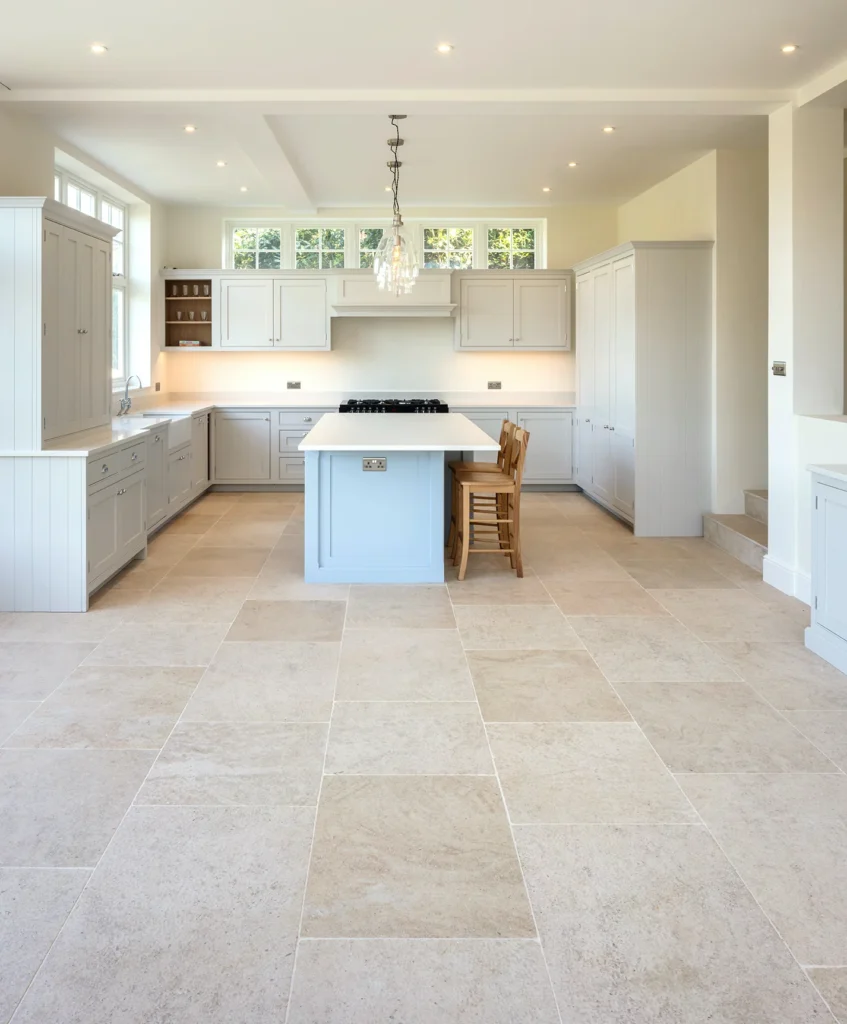
Natural stone kitchen and floor tiles provide unmatched authenticity and character that create unique installations impossible to replicate with manufactured materials, offering timeless beauty and excellent long-term value while requiring specific care and maintenance considerations.
Popular Natural Stone Kitchen and Floor Tiles:
- Marble tiles offering luxury aesthetics with distinctive veining patterns
- Granite tiles providing exceptional durability and stain resistance
- Travertine tiles creating warm, earth-tone beauty with natural texture
- Slate tiles delivering dramatic color variations and slip resistance
- Limestone tiles providing subtle beauty with excellent workability
- Quartzite tiles combining beauty with superior durability
- Sandstone tiles offering natural texture and warm color palettes
- Exotic stones including onyx and serpentine for unique applications
Marble kitchen and floor tiles represent the pinnacle of luxury natural stone, with distinctive veining patterns and lustrous surfaces that create stunning installations. Popular varieties include Carrara, Calacatta, and Emperador marbles, each offering unique characteristics and color palettes that enhance kitchen designs while requiring specific care to maintain their beauty.
Granite kitchen and floor tiles provide exceptional durability and stain resistance that make them practical for high-use kitchen applications while offering natural beauty and prestige. The dense composition of granite makes it highly resistant to scratches, heat, and stains while providing unique patterns and colors that vary with each installation.
Travertine kitchen and floor tiles offer warm, earth-tone beauty with natural texture that creates inviting atmospheres while providing good durability for kitchen applications. The natural pores in travertine can be filled during processing to create smoother surfaces, or left unfilled to maintain authentic texture and character.
Slate kitchen and floor tiles provide dramatic color variations and natural slip resistance that make them both beautiful and practical for kitchen installations. The natural cleft surface of slate provides excellent traction while creating distinctive textures that enhance contemporary and traditional designs.
Professional sealing and maintenance preserve the beauty and performance of natural stone kitchen and floor tiles, with appropriate sealers providing enhanced stain and moisture resistance while maintaining the stone’s natural appearance. Regular maintenance ensures that natural stone tiles retain their beauty and performance over decades of use.
4. Ceramic Kitchen and Floor Tiles: Versatile and Affordable Options
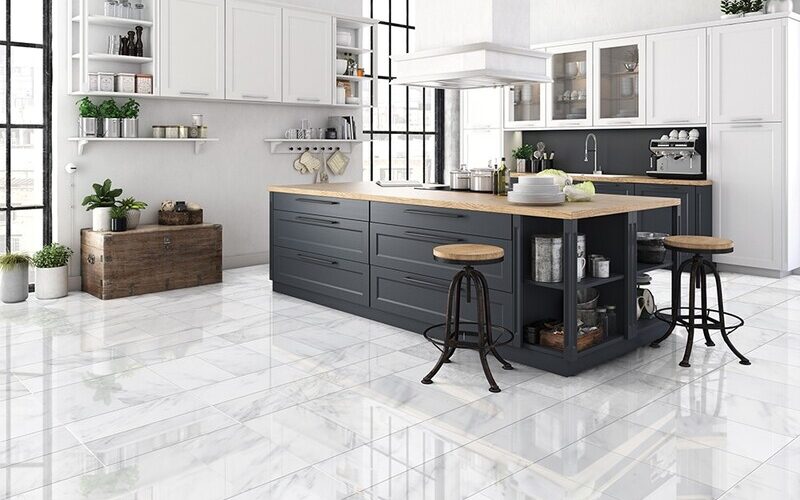
Ceramic kitchen and floor tiles continue to provide excellent value and versatility for homeowners seeking attractive, durable flooring solutions that accommodate various design styles and budget requirements while offering reliable performance in kitchen environments.
Ceramic Kitchen and Floor Tiles Advantages:
- Affordable pricing making quality tiles accessible to most budgets
- Wide variety of colors, patterns, and sizes accommodating all design styles
- Good durability and stain resistance for most residential applications
- Easy installation suitable for DIY projects with proper preparation
- Low maintenance requirements supporting busy lifestyles
- Excellent design flexibility enabling creative pattern installations
- Established installation techniques with readily available materials
- Environmental friendliness through natural clay composition
Modern ceramic kitchen and floor tiles have evolved significantly from basic options, with advanced glazing techniques and improved manufacturing creating products that offer enhanced durability and aesthetic appeal while maintaining affordable pricing that makes quality tiles accessible to most homeowners.
The glazing process for ceramic kitchen and floor tiles creates protective surfaces that resist stains, moisture, and wear while enabling unlimited color and pattern possibilities. Modern glazes can create matte, glossy, or textured finishes that provide both aesthetic appeal and functional benefits including slip resistance.
Size variety in ceramic kitchen and floor tiles enables creative design applications, with options ranging from small mosaic tiles to large format rectangles that can create different visual effects and accommodate various installation patterns. Popular sizes include 12×12, 12×24, and 18×18 inches for floor applications.
The established manufacturing and installation techniques for ceramic kitchen and floor tiles ensure reliable results with readily available materials and experienced installers. This maturity in the market provides confidence in material performance and installation quality while keeping costs reasonable.
Color and pattern variety in ceramic kitchen and floor tiles enables accommodation of any design style, from traditional to contemporary, with options including solid colors, patterns, textures, and designs that mimic natural materials at fraction of the cost of authentic alternatives.
5. Large Format Kitchen and Floor Tiles: Modern Aesthetics and Practical Benefits
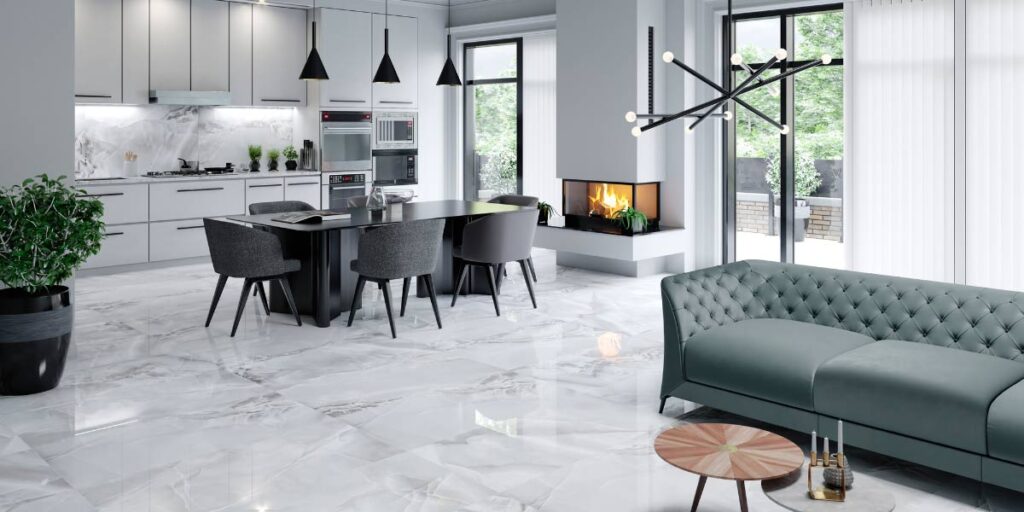
Large format kitchen and floor tiles represent a significant trend in contemporary design, offering dramatic visual impact while providing practical benefits including reduced grout lines, faster installation, and easier maintenance that make them attractive for modern kitchen applications.
Large Format Kitchen and Floor Tiles Benefits:
- Seamless appearances with minimal grout lines creating contemporary aesthetics
- Reduced installation time through coverage of larger areas per tile
- Lower maintenance requirements due to fewer grout lines
- Enhanced spatial perception making rooms appear larger
- Superior design impact through uninterrupted surface patterns
- Professional appearance rivaling natural stone slabs
- Improved hygiene through reduced grout accumulation areas
- Cost efficiency through reduced labor and material requirements
The trend toward large format kitchen and floor tiles reflects contemporary design preferences for clean, uninterrupted surfaces that create sophisticated appearances while providing practical benefits. Common large format sizes include 24×48, 32×32, and even larger formats that approach slab dimensions.
Installation of large format kitchen and floor tiles requires specific techniques and tools to ensure proper support and prevent cracking or lippage that can occur with oversized tiles. Professional installation is often recommended to achieve optimal results and maintain warranty coverage for premium materials.
The visual impact of large format kitchen and floor tiles can dramatically transform spaces by creating seamless surfaces that enhance lighting and spatial perception. The reduced number of grout lines creates cleaner appearances that work particularly well in contemporary and minimalist design approaches.
Handling and transportation considerations for large format kitchen and floor tiles require special equipment and techniques due to their size and weight. Proper planning and professional handling ensure that these premium materials are installed without damage while achieving optimal results.
The manufacturing advances that enable large format kitchen and floor tiles include improved pressing techniques, enhanced kiln technology, and better quality control that ensure flatness and dimensional accuracy essential for successful installation of oversized tiles.
6. Kitchen and Floor Tiles Installation: Professional Techniques and Best Practices
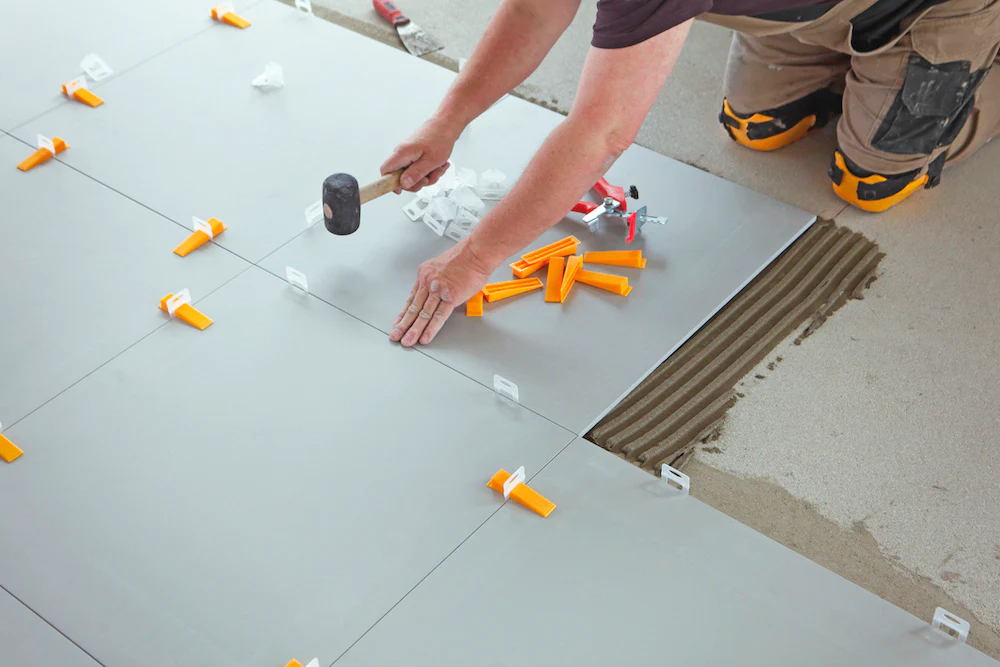
Proper installation of kitchen and floor tiles requires understanding substrate preparation, adhesive selection, layout planning, and finishing techniques that ensure optimal performance and longevity while maintaining aesthetic appeal and warranty coverage for quality materials.
Essential Kitchen and Floor Tiles Installation Steps:
- Comprehensive substrate evaluation and preparation
- Moisture testing and vapor barrier installation when required
- Accurate measurement and layout planning for optimal appearance
- Appropriate adhesive selection based on tile type and application
- Proper tile setting techniques ensuring full adhesive contact
- Precise cutting and fitting around obstacles and edges
- Professional grouting with appropriate materials and techniques
- Final cleaning and sealing to protect the installation
Substrate preparation forms the foundation of successful kitchen and floor tiles installation, with proper evaluation and preparation of subfloors ensuring optimal adhesion and preventing problems including cracking, hollow spots, and premature failure. Concrete subfloors must be level, clean, and properly cured, while wood subfloors require appropriate underlayment and deflection control.
Moisture testing becomes critical for kitchen and floor tiles installation, as excessive moisture in substrates can cause adhesive failure and tile problems even with waterproof materials. Proper moisture barriers and vapor retarders protect installations while ensuring long-term performance and warranty compliance.
Layout planning ensures optimal appearance in kitchen and floor tiles installation by establishing reference lines that create balanced, professional-looking results. Proper layout minimizes cut tiles at visible edges while ensuring that patterns align correctly and create the desired visual effect.
Adhesive selection significantly impacts the performance of kitchen and floor tiles installation, with different adhesives required for different tile types, sizes, and applications. Modified thin-set mortars provide enhanced bond strength and flexibility, while specialized adhesives may be required for large format or natural stone tiles.
Professional cutting techniques ensure precise fits around cabinets, appliances, and other obstacles in kitchen and floor tiles installation. Wet saws, angle grinders, and specialized cutting tools enable clean, accurate cuts that maintain professional appearance while ensuring proper fit and function.
7. Maintenance and Care for Kitchen and Floor Tiles
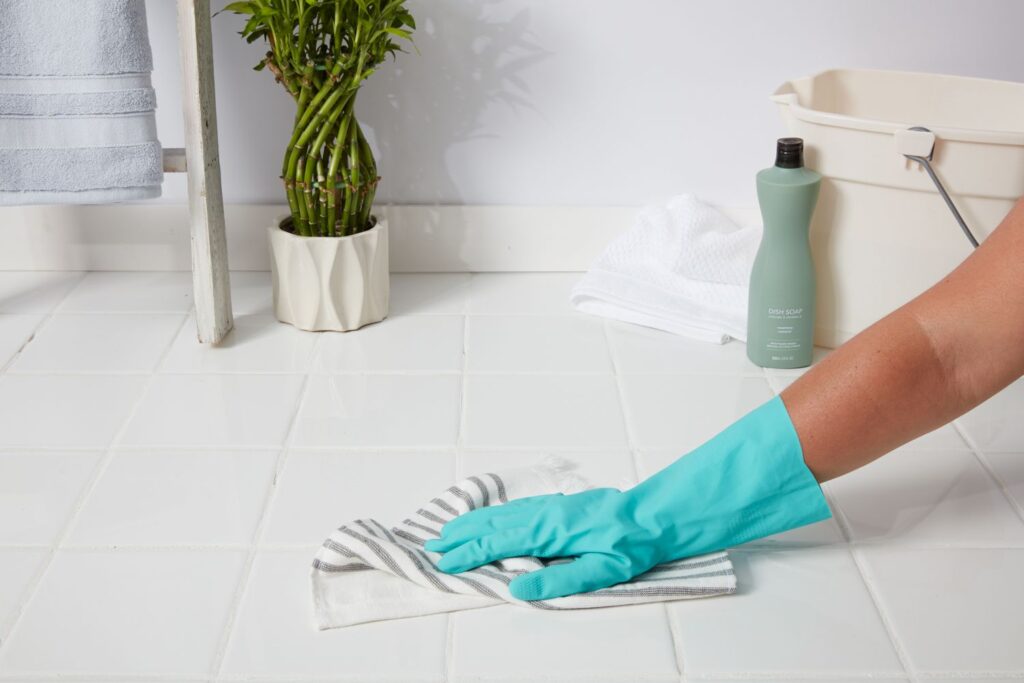
Proper maintenance and care preserve the beauty and performance of kitchen and floor tiles while extending their lifespan and protecting the investment in quality materials through appropriate cleaning techniques, preventive measures, and periodic professional maintenance.
Kitchen and Floor Tiles Maintenance Guidelines:
- Daily cleaning routines maintaining appearance and hygiene
- Appropriate cleaning products preserving tile and grout integrity
- Preventive measures protecting against damage and staining
- Periodic deep cleaning removing accumulated soil and residues
- Grout maintenance including cleaning, sealing, and repair
- Professional restoration services when needed
- Damage prevention through proper use and protection
- Long-term care planning ensuring continued performance
Daily maintenance of kitchen and floor tiles involves sweeping or vacuuming to remove loose dirt and debris that can cause scratching, followed by damp mopping with appropriate cleaners that maintain tile and grout appearance without causing damage. pH-neutral cleaners work best for most tile types while preserving grout integrity.
Grout maintenance represents a critical aspect of kitchen and floor tiles care, as grout lines can accumulate soil, stains, and bacteria that affect both appearance and hygiene. Regular cleaning with appropriate products and periodic sealing help maintain grout appearance and performance while preventing problems.
Stain prevention and prompt cleanup protect kitchen and floor tiles from permanent damage, with immediate attention to spills preventing penetration and staining that can be difficult or impossible to remove. Different tile types require different approaches to stain prevention and removal.
Professional cleaning and restoration services can restore the appearance of kitchen and floor tiles when regular maintenance is insufficient, with specialized equipment and techniques removing deep stains, restoring grout color, and addressing damage that affects appearance and performance.
Protective measures including entrance mats, furniture pads, and appropriate use help prevent damage to kitchen and floor tiles while extending their lifespan and maintaining appearance. Understanding the limitations and proper use of different tile types prevents problems and maintains warranty coverage.
8. Design Trends and Styling with Kitchen and Floor Tiles
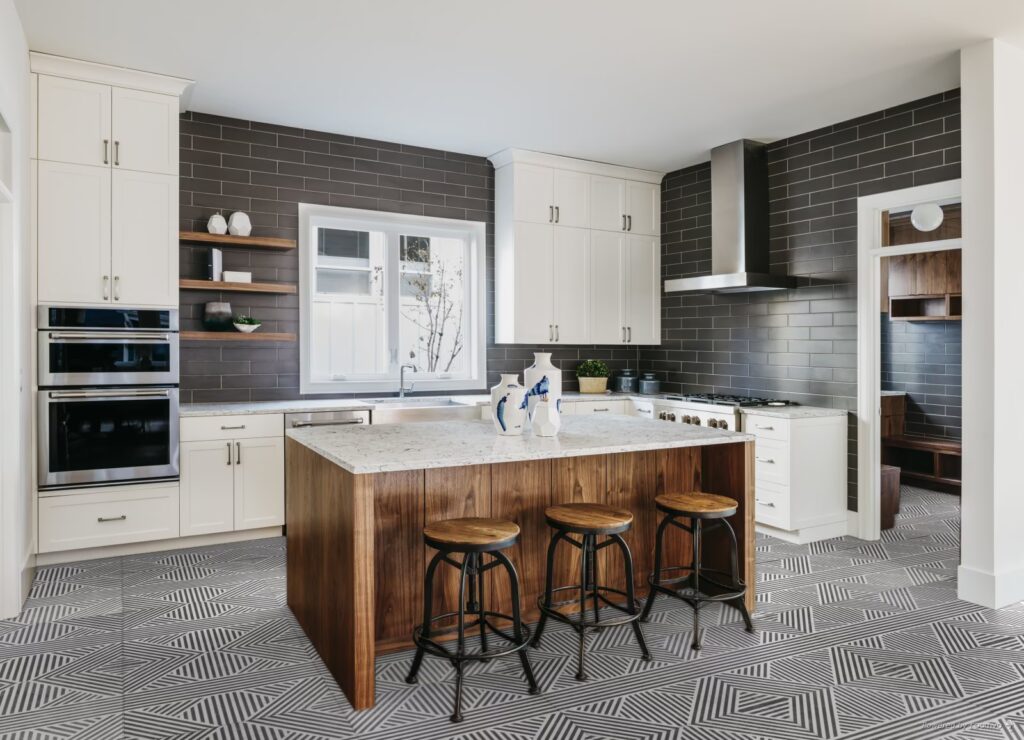
Contemporary design trends in kitchen and floor tiles reflect evolving aesthetic preferences, technological capabilities, and lifestyle requirements that influence material selection, installation patterns, and styling approaches that create distinctive, functional spaces.
Current Kitchen and Floor Tiles Design Trends:
- Large format tiles creating seamless, contemporary appearances
- Wood-look tiles combining natural aesthetics with tile performance
- Geometric patterns and creative layouts adding visual interest
- Mixed material installations combining different tile types
- Textured surfaces providing tactile interest and slip resistance
- Bold colors and patterns creating focal points and personality
- Sustainable materials addressing environmental concerns
- Smart integration incorporating technology into tile installations
Wood-look kitchen and floor tiles have gained tremendous popularity by combining the warm, natural appearance of hardwood with the durability and water resistance of ceramic or porcelain materials. Advanced printing technology creates incredibly realistic wood grain patterns and textures that are virtually indistinguishable from natural wood.
Geometric patterns in kitchen and floor tiles create dynamic visual effects through creative layouts including herringbone, chevron, hexagonal, and custom patterns that add personality and sophistication to installations. These patterns work with various tile sizes and materials to create unique design statements.
Mixed material installations combine different types of kitchen and floor tiles to create custom designs that optimize performance while creating visual interest. Popular combinations include stone and wood-look tiles, different sizes of the same material, or contrasting colors and textures.
Textured kitchen and floor tiles provide both aesthetic and functional benefits by creating visual depth while offering slip resistance essential for safety in kitchen environments. Options include embossed surfaces, natural stone textures, and three-dimensional patterns that enhance design impact.
The trend toward sustainable kitchen and floor tiles reflects growing environmental consciousness, with manufacturers developing products using recycled content, reduced energy manufacturing processes, and materials that support green building certification programs while maintaining performance and aesthetic standards.
Conclusion
Kitchen and floor tiles represent one of the most important design and functional decisions in kitchen renovation and construction, with proper selection and installation providing decades of beauty, performance, and value. Understanding the various types of kitchen and floor tiles available enables informed decisions that balance aesthetic goals with practical requirements.
Porcelain kitchen and floor tiles continue to gain popularity due to their superior performance characteristics, design versatility, and technological advances that create options previously impossible with traditional materials. These tiles provide excellent durability and water resistance while offering unlimited design possibilities.
Natural stone kitchen and floor tiles provide unmatched authenticity and character that create unique installations while requiring specific care and maintenance considerations. The investment in natural stone tiles typically provides excellent long-term value through durability and timeless appeal.
Ceramic kitchen and floor tiles remain popular due to their affordability, versatility, and reliable performance that makes quality tile installations accessible to most homeowners while providing excellent design flexibility and established installation techniques.
Large format kitchen and floor tiles represent significant trends in contemporary design, offering dramatic visual impact while providing practical benefits including reduced maintenance and faster installation that make them attractive for modern applications.
Proper installation and maintenance of kitchen and floor tiles ensure optimal performance and longevity while protecting the investment in quality materials. Professional installation and appropriate care preserve beauty and functionality while maintaining warranty coverage.
The future of kitchen and floor tiles includes continued innovation in materials, manufacturing techniques, and design possibilities that expand options while improving performance characteristics and environmental responsibility.
How do I choose the right size kitchen and floor tiles for my space?
Choosing the right size kitchen and floor tiles depends on room dimensions, design goals, and practical considerations. Large format tiles (24x48 inches or larger) work well in spacious kitchens and create contemporary, seamless appearances while making spaces appear larger. Medium tiles (12x24 or 18x18 inches) provide versatility for most kitchen sizes, while smaller tiles work better in compact spaces or for creating detailed patterns. Consider that larger tiles require flatter subfloors and more precise installation, while smaller tiles offer more design flexibility but create more grout lines requiring maintenance.
What's the difference between ceramic and porcelain kitchen and floor tiles?
The main differences between ceramic and porcelain kitchen and floor tiles lie in density, water absorption, and durability. Porcelain tiles are fired at higher temperatures, creating denser, less porous surfaces with water absorption rates below 0.5%, making them virtually waterproof. Ceramic tiles are more porous with higher water absorption rates, making them less suitable for areas with heavy moisture exposure. Porcelain offers superior durability, stain resistance, and freeze-thaw resistance, while ceramic tiles are more affordable and easier to cut and install. Both can be used for kitchen applications, but porcelain provides better long-term performance.
How much should I budget for kitchen and floor tiles installation?
Kitchen and floor tiles installation costs vary significantly based on tile type, size, pattern complexity, and local labor rates. Basic ceramic tile installation typically ranges from $8-15 per square foot including materials and labor, while premium porcelain or natural stone installations can cost $15-30 per square foot or more. Large format tiles, complex patterns, and extensive substrate preparation increase costs. Additional expenses include removal of existing flooring ($2-5 per square foot), substrate preparation, trim pieces, and potential plumbing or electrical modifications. Professional installation is recommended for premium materials to ensure warranty coverage and optimal results.
What maintenance do kitchen and floor tiles require to maintain their appearance?
Kitchen and floor tiles maintenance requirements vary by material type but generally include daily sweeping or vacuuming, weekly damp mopping with pH-neutral cleaners, and periodic deep cleaning. Grout lines require regular cleaning and periodic sealing (every 1-2 years) to maintain appearance and prevent staining. Natural stone tiles need specific cleaners and periodic sealing, while porcelain and ceramic tiles are more maintenance-friendly. Immediate cleanup of spills prevents staining, and entrance mats help reduce tracked dirt. Professional cleaning every few years can restore appearance and address issues beyond regular maintenance capabilities.
Sources/References
- Tile Council of North America – Technical Standards and Installation Guidelines https://www.tcnatile.com/
- Ceramic Tile Distributors Association – Product Standards and Specifications https://www.ctdahome.org/
- National Tile Contractors Association – Installation Best Practices https://www.tile-assn.com/
- American Society for Testing and Materials – Tile Performance Standards https://www.astm.org/
- Porcelain Tile Certification Agency – Quality Standards and Testing https://www.ptca.com/
- Natural Stone Institute – Stone Selection and Care Guidelines https://www.naturalstoneinstitute.org/
- Green Building Council – Sustainable Tile Selection Criteria https://www.usgbc.org/
- International Association of Certified Home Inspectors – Tile Installation Guidelines https://www.nachi.org/
